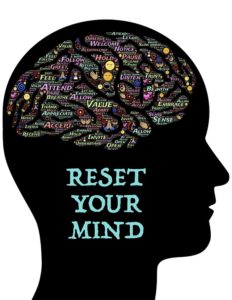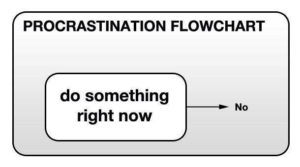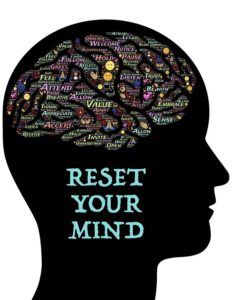Simple Self-Awareness: Part Three of Three
 Congrats on making it to part three! In part one we discussed the importance of a desire to change, we talked about two types of change we may want to make (creating new and replacing old), and we started to identify some changes that we may want to make. In part two we came back to our list and spent more time connecting with the importance of the “why”, then we started connecting deeper with the actions needed to be successful, and finally we explored what may derail us and some basic strategies to combat this. In this post we’re going to cover how to build awareness of our bad habits and strategy to start working on them.
Congrats on making it to part three! In part one we discussed the importance of a desire to change, we talked about two types of change we may want to make (creating new and replacing old), and we started to identify some changes that we may want to make. In part two we came back to our list and spent more time connecting with the importance of the “why”, then we started connecting deeper with the actions needed to be successful, and finally we explored what may derail us and some basic strategies to combat this. In this post we’re going to cover how to build awareness of our bad habits and strategy to start working on them.Habits are our friends…
 A quick word about habits. They’re awesome and they free up the prefrontal cortex of our brain. This allows us to be creative, deal with complexity, make plans, focus, control impulses, and more. My techie friends will recognize this value as offloading with specialized ASICS, but I digress. Controlling impulses will become more important as we’ll use this to break old habits, but first we’ll need to create more awareness. I do suggest readers learn more about how the brain works, but in this case you’ll want to read more about the limbic system. This article from Positive Psychology is a good read and speaks more to the science about what I’m covering.
A quick word about habits. They’re awesome and they free up the prefrontal cortex of our brain. This allows us to be creative, deal with complexity, make plans, focus, control impulses, and more. My techie friends will recognize this value as offloading with specialized ASICS, but I digress. Controlling impulses will become more important as we’ll use this to break old habits, but first we’ll need to create more awareness. I do suggest readers learn more about how the brain works, but in this case you’ll want to read more about the limbic system. This article from Positive Psychology is a good read and speaks more to the science about what I’m covering.Finding the Gremlins
 Onto the harder changes to address. Bad habits! We all have them and it’s worth reiterating that there’s little value in judging ourselves, or others, over them. Some of the bad habits we’re aware of, but sometimes we’re not. How do we become aware of habits that don’t sit well with others or prevent us from moving forward in our goals? Unless you’re surrounded by people that care about you and have strong candor, as in the type that will tell you about the booger on your face, then the next best option is to pursue a 360-feedback or multi-rater survey tool. Some employers will offer this kind of tool, but there are some options online as well. The first experience I ever had with something like this by accident in my early twenties. It was part of a course I took which focused on organization and time management. Part of me was curious to see how my peers felt about me, but another part was not interested at all! It turned out to be one of the best things I could have done for myself and provided me with many opportunities to improve. Better yet, it opened my mind to the value of feedback and created a desire to make this a regular practice going forward. If a 360 feedback survey is not available, then another option is to simply ask others for feedback. To the extent we make it safe for them to do so, most people are willing to share how they observe and experience us. If you’re aware of something specific you want to work on, then you can prime these topics with others to observe and report back.
Onto the harder changes to address. Bad habits! We all have them and it’s worth reiterating that there’s little value in judging ourselves, or others, over them. Some of the bad habits we’re aware of, but sometimes we’re not. How do we become aware of habits that don’t sit well with others or prevent us from moving forward in our goals? Unless you’re surrounded by people that care about you and have strong candor, as in the type that will tell you about the booger on your face, then the next best option is to pursue a 360-feedback or multi-rater survey tool. Some employers will offer this kind of tool, but there are some options online as well. The first experience I ever had with something like this by accident in my early twenties. It was part of a course I took which focused on organization and time management. Part of me was curious to see how my peers felt about me, but another part was not interested at all! It turned out to be one of the best things I could have done for myself and provided me with many opportunities to improve. Better yet, it opened my mind to the value of feedback and created a desire to make this a regular practice going forward. If a 360 feedback survey is not available, then another option is to simply ask others for feedback. To the extent we make it safe for them to do so, most people are willing to share how they observe and experience us. If you’re aware of something specific you want to work on, then you can prime these topics with others to observe and report back.May cause mood swings

If you’re curious to know what you don’t know, then we’ll explore a different approach. BEFORE YOU MOVE ON, IT’S CRITICAL THAT YOU MAKE IT SAFE FOR OTHERS TO SHARE! This implies that you CAN TAKE the feedback well. If you struggle with this, then my suggestion would be to skip to the next paragraph and assume you got needed feedback from a 360 review. On receiving feedback, I tell others to not respond, but rather say thank you. Understand that you do things you’re not aware of and you’re not a bad person because of it! There are other cases where we know we do it, but we don’t know how to stop or we’re afraid to. Don’t judge yourself. Consider the possibility that others see you in small windows of time and form opinions based on what they observe and experience. We all do it! Assume it’s an accurate reflection and try it on. Consider what you may have been doing, or not doing, that could have led to this impression. If you can avoid reacting poorly, then you want to ask questions such as “When do you find me less persuasive? What do you observe that may cause this?” or “What habits do I have that get on your nerves? When do you see these? Do I always do it?”. Take note of what you’re hearing and avoid trying to shape it in a way that rationalizes it to your ego. Once you try on the clothes, then you have to consider if you want to keep them. There are times where we decide we don’t need or want to work on something and this is not a problem. You’ll want to consider whether your short-term or long-term goals are at risk if you choose to not work on the area identified.
Seek more knowledge
 Assuming we have received feedback, we’ll want to learn as much as we can. We’ll want to know what the environment is like when the habit is active, is it consistent or intermittent, and how do we feel when it’s intermittent. The more we study the behavior and the state in in which it occurs, the more insight we’ll have to start working on it. This can take time to get in touch with, so be patient. Becoming self-aware is a continual practice and, like a muscle, will get stronger over time as we exercise it. That said, if you’ve not been doing any physical exercise, expecting to be the next crossfit champion in a few weeks is going to lead to frustration. The same applies here…patience and practice is the way.
Assuming we have received feedback, we’ll want to learn as much as we can. We’ll want to know what the environment is like when the habit is active, is it consistent or intermittent, and how do we feel when it’s intermittent. The more we study the behavior and the state in in which it occurs, the more insight we’ll have to start working on it. This can take time to get in touch with, so be patient. Becoming self-aware is a continual practice and, like a muscle, will get stronger over time as we exercise it. That said, if you’ve not been doing any physical exercise, expecting to be the next crossfit champion in a few weeks is going to lead to frustration. The same applies here…patience and practice is the way.And now for something completely different!
 We address this situation by finding alternative actions to take provide the same value and then we start practicing them. What other ways could we check-in with our audience to see if they’re still with us? Instead of saying “Blah blah blah…cool technology blah blah awesome blah blah….right?” we could say “I’m finding this technology is heating up and may have potential to displace others in this space. Is anyone else experiencing or seeing this?”. We could also invite others to provide opposing views or other perspectives to consider and then we move on with our goal. If it’s to persuade, then we support our position while inviting perspective to consider and work through. If we’re trying to inform, then we should continue to do so. The point we’ll take from here is that we have an alternative behavior to practice.
We address this situation by finding alternative actions to take provide the same value and then we start practicing them. What other ways could we check-in with our audience to see if they’re still with us? Instead of saying “Blah blah blah…cool technology blah blah awesome blah blah….right?” we could say “I’m finding this technology is heating up and may have potential to displace others in this space. Is anyone else experiencing or seeing this?”. We could also invite others to provide opposing views or other perspectives to consider and then we move on with our goal. If it’s to persuade, then we support our position while inviting perspective to consider and work through. If we’re trying to inform, then we should continue to do so. The point we’ll take from here is that we have an alternative behavior to practice.Best of wishes in your journey
Five limiting beliefs you should let go of today!
 The Power of Belief
The Power of Belief
In 1999 I made very little money, had dropped out of three colleges, and was newly married. Two years prior that that I was unemployed. Needless to say, I had plenty of opportunity to carry around limiting beliefs. That said, I’m confident I would not have become an executive thirteen years later at the 8th largest privately held company in the US had I done so.
What we choose to believe about ourselves, our environments, our opportunities and more has a significant impact on our ability to change and succeed. There have been plenty of studies showing this to be true, but here’s one from Scientific American talking about simple beliefs improving eyesight and helping with weight loss! In the case of the weight loss, they told a group of hotel room attendants that they were getting the recommended amount of exercise a week and were found to have improvements in BMI, body fat percentage, and blood pressure.
Our brains may be holding us back
If we know this to be true, why do many people continue to talk about what we can’t do or how it won’t work? Not only that, but these same people want better outcomes and success! There’s more science behind negative bias and how we’re wired in this way. An article from Psychology Today points out that the amygdala, which is responsible for our fight or flight response, uses two thirds of it’s neurons to detect negative experiences.
My experience in coaching others is that many people actively, or subconsciously, avoid getting their hopes up in FEAR they’ll fail, be let down, it won’t work out etc.. For many, the limiting beliefs provide a form of protection. For anyone looking to thrive and begin tackling the challenges they’ve been avoiding, here are five stories to stop telling yourself today!
Five beliefs to let go of today!
- I don’t know enough – What does enough look like? How can we start learning now? Who can help us?
- There’s not enough time – What’s taking up your time now? What can you let go of or delegate?
- I’ll be told no if I ask – You’ll never no or slow down the process if you don’t ask! Go ask!
- I can’t do that – What’s preventing you from doing so? Our brains all learn the same way, so it seems some learning and practice will provide the capability needed.
- I don’t have enough money – Is there ever enough money? I find most spend proportionally to how much they make and never seem to have “enough”. Even those who win the lottery find they don’t have “enough”. That said, how much is enough? Where can you acquire the money? Is there a smaller scale plan that could be used for now?
What other beliefs can you let go of?
I’m confident we all have many more than five, but these were on my mind and come up in conversation quite a bit. Take some time to write down the various reason why things are not working out and then throw them away or burn them. What new stories can you tell yourself? What new beliefs can you adopt that are aligned to where you’re trying to go?
Simple Self-Awareness: Part Two of Three
So much to do!
 I know you have a long list of things you want to tackle by now, so let’s get going! In part one we discussed how self-awareness can help us and about two types of changes with differing demands. I also said we would dive a bit deeper into motivation and the first kind of change, being the “Creating” type, so let’s get going!
I know you have a long list of things you want to tackle by now, so let’s get going! In part one we discussed how self-awareness can help us and about two types of changes with differing demands. I also said we would dive a bit deeper into motivation and the first kind of change, being the “Creating” type, so let’s get going!
How bad do you want it!?
 At this point you have various changes you want to make. Take some time to write them down, if you have not already, and then circle the ones that align to the creating type. Think of the change you want to make that currently has the most mind share or is at the top of your list. Try and rate your desire to make this change between one and ten. If you’re at a five or below, then it’s time to question how bad you want it! If you’re at a six or seven, what would it take to bring up to eight, nine, or ten? If it’s actionable, then write it down and start thinking about how to move it forward. If you’re still not able to get to an eight or higher, then spend some time going through your list with this process to see if you register eight or higher.
At this point you have various changes you want to make. Take some time to write them down, if you have not already, and then circle the ones that align to the creating type. Think of the change you want to make that currently has the most mind share or is at the top of your list. Try and rate your desire to make this change between one and ten. If you’re at a five or below, then it’s time to question how bad you want it! If you’re at a six or seven, what would it take to bring up to eight, nine, or ten? If it’s actionable, then write it down and start thinking about how to move it forward. If you’re still not able to get to an eight or higher, then spend some time going through your list with this process to see if you register eight or higher.
Time for action!

Now, you either have something you’re driven to change, or you’ve just learned there’s less passion around some of your goals. If the latter is true, you’ll want to spend some time reviewing your original list and work towards an eight or higher. For those of you that are ready to keep going, please take some time to write down what it looks like to be successful. What do you see yourself doing or practicing and how consistent will you be? How long do you practice? Where do you practice? Who helps you? What does it look like when you celebrate milestones? When you’re successful, happy, and fulfilled in your progress, what have you done that creates these feelings?
Great! We now have a destination and the mental fuel to get going, so now what? We need to go back to our list of what’s preventing us from moving forward. Some of the most common things are time, current health, current finances etc.. Some next steps in these cases may be time budgeting, change of diet, simple exercises, or basic financial budgeting. Despite the many books dedicated to this area I find this to be the easier part. I’m not saying it’s not challenging or or there’s no value in the teachings from these books. I’m saying there are known processes to follow that will address these kinds of problems. The need to focus on self-awareness becomes clearer during the doing phase of things.
We have met the enemy and it is us!
 Let’s use learning a new language as our simple goal. To learn a new language you have to speak it out loud and preferably with others. The obvious blockers will be time to practice and people people to practice with. We’ll say we did some basic time budgeting and cut out some television shows to make the time to practice alone. We also connected with someone we knew in the community, that could speak natively, and they agreed to make time to practice with us over coffee. Things are going great, now it’s only a matter of time right? It’s during the execution where our brains and subconscious work against us with all the best intentions. Our brains are wired to keep us safe. This can mean avoiding discomfort from exercise, practicing something new, being vulnerable, etc..
Let’s use learning a new language as our simple goal. To learn a new language you have to speak it out loud and preferably with others. The obvious blockers will be time to practice and people people to practice with. We’ll say we did some basic time budgeting and cut out some television shows to make the time to practice alone. We also connected with someone we knew in the community, that could speak natively, and they agreed to make time to practice with us over coffee. Things are going great, now it’s only a matter of time right? It’s during the execution where our brains and subconscious work against us with all the best intentions. Our brains are wired to keep us safe. This can mean avoiding discomfort from exercise, practicing something new, being vulnerable, etc..
There’s hope!
 On high stress days, we may look for ways to reduce it by incorporating mindfulness. We may avoid engaging in projects that would increase stress. In regards to not liking how we sound, we may acknowledge that we’re not where we want to be yet and that it’s part of the journey. From there we re-commit to practicing with the understanding it will come with time. What about the negative feeling associated with being corrected? We may acknowledge it and let our friend know, so they can help us stay committed while we’re practicing.
On high stress days, we may look for ways to reduce it by incorporating mindfulness. We may avoid engaging in projects that would increase stress. In regards to not liking how we sound, we may acknowledge that we’re not where we want to be yet and that it’s part of the journey. From there we re-commit to practicing with the understanding it will come with time. What about the negative feeling associated with being corrected? We may acknowledge it and let our friend know, so they can help us stay committed while we’re practicing.
Positive News Stories for the Week: Because it’s not all doom and gloom
 Throughout the world we’re drawn to negative news, drama, crisis, etc., but the fact of the matter is there are a lot of great things going on. Because these stories don’t draw as much attention, and therefore revenue dollars, we find ourselves in a world where we have to seek out the positivity more than we should. To that end, here are some stories that I found today and felt they were worth sharing to start the week off on a good note. Enjoy!
Throughout the world we’re drawn to negative news, drama, crisis, etc., but the fact of the matter is there are a lot of great things going on. Because these stories don’t draw as much attention, and therefore revenue dollars, we find ourselves in a world where we have to seek out the positivity more than we should. To that end, here are some stories that I found today and felt they were worth sharing to start the week off on a good note. Enjoy!
I like the idea that anyone hungry enough can go create value to the world and feed themselves with little overhead or barrier of entry.
I expect soda will eventually go the route of cigarettes…that’s how bad it is for us. That said, I’m happy to see a change in the trend.
Hope For Obesity: First Time in Modern Memory, Americans Drank More Water Than Soda
Love makes the world go round….do your part!
4-Year-Old’s Teacher Donates Kidney to Father In Need: ‘She’s An Amazing Lady’
Simple Self-Awareness: Part one of three
 The vast majority of my success thus far has come from my ability to adapt and change. Over time I have come to realize that at the heart of this ability is a high level of self-awareness. I have always been an introspective person and feel being an introvert has helped to further develop it over time. In my life I’ve received feedback from others, including multiple professional coaches, about the level of self awareness I have and some telling me I have more self awareness than anyone they’ve ever met. Considering they work with many C-suite types, it has started to pique my interest as something I could pass on to others. Being someone who wants to help as many people as possible while I’m alive, I want everyone to prosper from the same self-awareness as I have. This is the first of a three part series that I intend to help move this goal forward.
The vast majority of my success thus far has come from my ability to adapt and change. Over time I have come to realize that at the heart of this ability is a high level of self-awareness. I have always been an introspective person and feel being an introvert has helped to further develop it over time. In my life I’ve received feedback from others, including multiple professional coaches, about the level of self awareness I have and some telling me I have more self awareness than anyone they’ve ever met. Considering they work with many C-suite types, it has started to pique my interest as something I could pass on to others. Being someone who wants to help as many people as possible while I’m alive, I want everyone to prosper from the same self-awareness as I have. This is the first of a three part series that I intend to help move this goal forward.
There’s somewhat of a chicken and egg problem in regards to where one would start. The gist of the problem is that to be effective at making change you need self awareness, so what do we do when self-awareness is not high to start with? It’s the desire to change that will motivate the introspection needed to increase self-awareness.
For now I’ll say that a true desire to change is the first priority. I’m deliberate with the word ‘true’, because if it’s not real it can lead to an inability to see what’s preventing progress. We’ll need to have a deep commitment to make a sustaining change. If we say the desire to make a change is the direction in which you want to travel, then the commitment will be the fuel that gets you there. Continuing with the metaphor, we need to fuel up before we take off. We’ll discuss this further in later posts, but behind this is a theme of “How bad do you want this?”.
On many occasions I’ve met with others who liked the idea of achieving a goal, such as running a 5k, but they lacked the commitment. It’s important to not beat yourself up or cast judgment. Doing so prevents us from learning that the passion is not there and moving on to where it is. You’ll find the commitment when the need to change is standing between you and your passion.
Once we have the direction and fuel sorted out, then comes the journey. This is where the rubber meets the road and there are two types of change that i’ll focus on in this series. The first type of change is one of creating. This may look like learning to cook, running a 5k, etc.. The general theme is we’re trying to do something new. The key with this type is there’s no need to stop, remove, or replace an existing behavior to be successful. The second type of change is more difficult as it requires us to stop and/or replace one behavior or activity with another.
The self-awareness challenge with these two types are different and is I why separate them from each other. The first type focuses on awareness of what hinders time management and the ability to take action. The challenge with the latter type is a need to detect automatic responses and behaviors, pause, and choose a new one. Needless to say, when someone cuts you off in traffic it’s challenging to not react, pause, and then smile and bless them.
There are various strategies used to address these kind of challenges and since we’re all different, there’s no single “right way”. Regardless of the approach, involving others greatly improves the probability of success. Involving others creates accountability that motivates us to stay the course. We also receive feedback that helps us see what we can’t and to know when we’re making progress. While waiting on the next part of the series, take some time to list some changes you’re interested in making. Under each change on your list, add the challenges that prevent you from moving forward. Take some time considering your awareness of these challenges and take note what you’re aware of. What behaviors and motivations are getting in the way? Ask some trusted friends for feedback. What do they observe?
In the next part we’ll dig a little deeper into “How bad do you want it?” theme and start focusing on how to handle the first type of change.
We’re happy to work with you if you’re looking for help, so don’t hesitate to reach out.
